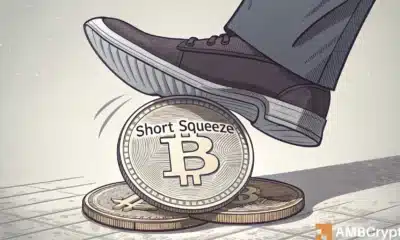Press Release
Bitcoin’s price swings under scrutiny as iFOREX Europe provides trading insights

Recent developments in the cryptocurrency market have spotlighted Bitcoin’s volatile nature, especially in light of geopolitical tensions and evolving market conditions. Bitcoin’s price reached a record high in March 2024, crossing the $71,000 mark. This milestone was seen by many as a testament to the cryptocurrency’s resilience, particularly following the fallout from the FTX scandal in late 2022. The scandal had cast a shadow over the industry, raising doubts about its stability.
Adding to the momentum, the London Stock Exchange announced in March that it would allow institutional traders to engage in Bitcoin and Ether ETNs (exchange-traded notes). These financial instruments offer returns based on the performance of an underlying asset, payable only at maturity. This move is seen as a significant step toward broadening institutional involvement in the cryptocurrency sector, echoing the earlier introduction of spot Bitcoin ETFs in January. Such developments are viewed as crucial for the industry’s growth and mainstream acceptance.
Looking ahead, the next Bitcoin halving event is anticipated around April 20th. Historically, these events have triggered substantial bull runs. Halving reduces Bitcoin mining rewards by 50%, thereby slowing the rate at which new Bitcoins are introduced to the market. This mechanism helps counteract inflationary pressures on Bitcoin, potentially enhancing its appeal compared to traditional fiat currencies like the USD, which are susceptible to inflation.
However, Bitcoin’s status as a safe-haven asset remains contentious. Following Iran’s direct assault on Israel on April 14th, Bitcoin’s price dropped by 7.7%, its largest decline in a year. This reaction mirrored the performance of traditional risk assets, including stocks, suggesting that Bitcoin’s safe-haven narrative may not hold under significant geopolitical stress. Zaheer Ebtikar of Split Capital noted that escalating political tensions could further impede Bitcoin’s upward trajectory.
There is also debate among analysts regarding the impact of Bitcoin halving its price. While the May 2020 halving preceded a bull run, some argue this was part of a broader period of risk asset exuberance. The bull run following the second halving coincided with the initial surge of public interest in cryptocurrencies, which buoyed prices.
Additionally, expectations of a dovish stance from the US Federal Reserve have been influenced. Bitcoin’s market performance. Markus Thielen of 10X Research anticipated Bitcoin’s March peak, citing traders’ beliefs that the Fed would cut interest rates this year. However, mid-April economic indicators have challenged this view, suggesting that the US economy remains robust. Persistent inflation has led to reassessments of the likelihood of rate cuts, with risk assets, including Bitcoin, appearing vulnerable to significant price corrections.
Public confidence in cryptocurrencies continues to be affected by the 2022 scandals. Despite regulatory efforts by US authorities, underlying issues in the sector remain unresolved. Bloomberg highlighted that conditions enabling market manipulation, such as those exploited by FTX, still exist. Until substantial regulatory changes are implemented, skepticism towards the sector is likely to persist. The hype surrounding the upcoming Bitcoin halving may lead to a temporary surge in interest, but a subsequent cooling period could see renewed bearish trends.
For those interested in trading Bitcoin through CFDs (Contracts for Difference), iFOREX Europe offers a platform to navigate these volatile markets. Trading Bitcoin as CFDs allows traders to capitalize on both rising and falling prices. Unlike traditional trading, CFDs enable traders to set their own deal sizes and leverage their positions to potentially amplify returns.
iFOREX Europe, operating under the trading name of iCFD Limited, is regulated by the Cyprus Securities and Exchange Commission (CySEC) under license number 143/11. The company emphasizes that CFDs are complex instruments with a high risk of losing money due to leverage. A significant percentage of retail investor accounts lose money when trading CFDs with this provider. Prospective traders should thoroughly understand the mechanics and risks of CFD trading before participating.
About iFOREX Europe
iFOREX Europe (formerly known as ‘Vestle’) is the trading name of iCFD Limited, licensed and regulated by the Cyprus Securities and Exchange Commission (CySEC) under license number 143/11. iFOREX Europe provides a trading platform for a range of financial instruments, including cryptocurrencies, commodities, and forex. The company is committed to offering clients a comprehensive trading experience with a focus on education, support, and risk management.
iFOREX Europe (formerly known as ‘Vestle’) is the trading name of iCFD Limited, licensed and regulated by the Cyprus Securities and Exchange Commission (CySEC) under license # 143/11. The materials contained on this document have been created in cooperation with iFOREX Europe and should not in any way be construed, either explicitly or implicitly, directly or indirectly, as investment advice, recommendation or suggestion of an investment strategy with respect to a financial instrument, in any manner whatsoever.
CFDs are complex instruments and come with a high risk of losing money rapidly due to leverage. 77.25% of retail investor accounts lose money when trading CFDs with this provider. You should consider whether you understand how CFDs work and whether you can afford to take the high risk of losing your money. Please note: Calculations of past performance movements may represent the futures and not the underlying asset. Full disclaimer: https://www.iforex.eu/legal/analysis-disclaimer.html
Disclaimer: This is a paid post and should not be treated as news/advice.

